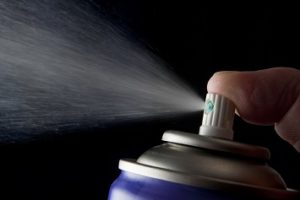It’s very likely that you use aerosol cans at your facility. They are pervasive in workplaces and in society as a whole. However, aerosol cans present significant environmental and safety hazards. We’ll take a look at some of these concerns and also offer some tips to reduce the use of aerosols.
Safe Use of Aerosol Cans in the Workplace
Aerosol cans that contain everything from starter fluids to hand cleaners are hazardous if stored in hot locations, punctured, thrown into an open fire, or otherwise improperly disposed of. Certain paints sprayed into or on the body in sufficient quantities or under sufficient pressure can cause death. Also, the hazard of fire from these materials must be reckoned with since a flammable liquid becomes an explosive mixture when atomized.
All aerosol cans present a hazard because of the compressed gas used as a propellant. If punctured, the contents may be released so forcefully that injuries can result. In addition, pressurized containers delivered to a landfill present safety concerns during compacting.
Tips for Working with Aerosol Cans
Workers who handle aerosol cans should be aware of the general hazards of aerosol cans and the hazards associated with the specific ingredients. They should follow proper storage and disposal procedures, including:
- Aerosol cans are pressurized containers. Since high temperatures can increase the pressure in a can to the point of explosion, never store cans at temperatures above 120 degrees Fahrenheit (°F).
- Avoid exposing cans to open flames or such hazards as a stove, radiator, fireplace, or space heater.
- Puncturing cans causes a sudden release of pressure that can turn the can into the equivalent of an unguided missile.
- Incinerating a can, even if it is empty, risks explosion.
- Aerosol cans that contain hazardous ingredients are required to have a warning label. Ingredients are considered hazardous if they have one or more of these characteristics:
- Flammable
- Toxic
- Caustic
- Irritant
- Sensitizer
- Carcinogen
- Nerve toxin
- Reproductive toxin.
- In addition to warnings of flammability and against puncture or incineration, other common warnings on aerosol cans include those of skin and eye irritation and accidental swallowing or inhaling.
Storing Aerosol Cans
Under the Occupational Safety and Health Administration’s (OSHA) standard for flammable liquids, a flammable aerosol is any nonrefillable container containing a compressed, liquefied, or dissolved flammable gas under pressure with a release device that ejects the contents as particles in suspension and emits a foam, paste, powder, liquid, or gas. The definition does not include flammable components that are pyrophoric, self-heating, or water-reactive chemicals. Flammable aerosols are Category 1 liquids (of four categories), which have a flashpoint below 73.4°F and a boiling point of 95°F or lower.
Note: The “flashpoint” is the lowest temperature at which a liquid gives off a vapor in enough concentration that it can be ignited when mixed with air near the surface of the liquid. A lower flashpoint means higher flammability.
Flammable liquids in containers of 60 gallons or less of flammable liquids (including flammable aerosol cans, paint thinners, etc.) must be kept in a fire-resistant storage cabinet or inside storage room rated for fire resistance.
Category 1 liquids may not be handled where vapors could encounter an ignition source. “No Smoking” signs must be conspicuously posted.
Check the SDS
Your workers should be trained and encouraged to check the safety data sheet (SDS) for handling and storage information specific to the aerosol that are using.
In tomorrow’s Advisor, we will take a look at disposal options for aerosol cans.


SDS for aerosol cans show storage requirements “Store locked up. Protect from sunlight. Do not expose to temperatures exceeding 50 °C/122 °F. Store in a well-ventilated place.”. Suppliers store them in open areas, racks and shelves. What is the storage requirement we are promoting here?